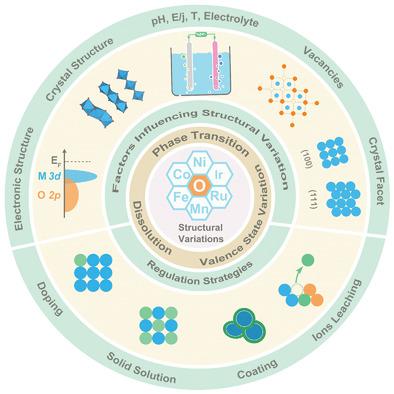当前位置:
X-MOL 学术
›
Small Methods
›
论文详情
Our official English website, www.x-mol.net, welcomes your
feedback! (Note: you will need to create a separate account there.)
Structural Variations of Metal Oxide-Based Electrocatalysts for Oxygen Evolution Reaction
Small Methods ( IF 10.7 ) Pub Date : 2021-10-27 , DOI: 10.1002/smtd.202100834 Ruiqin Gao 1 , Meng Deng 1 , Qing Yan 1 , Zhenxing Fang 2 , Lichun Li 3 , Haoyu Shen 1 , Zhengfei Chen 1
Small Methods ( IF 10.7 ) Pub Date : 2021-10-27 , DOI: 10.1002/smtd.202100834 Ruiqin Gao 1 , Meng Deng 1 , Qing Yan 1 , Zhenxing Fang 2 , Lichun Li 3 , Haoyu Shen 1 , Zhengfei Chen 1
Affiliation

|
Electrocatalytic oxygen evolution reaction (OER), an important electrode reaction in electrocatalytic and photoelectrochemical cells for a carbon-free energy cycle, has attracted considerable attention in the last few years. Metal oxides have been considered as good candidates for electrocatalytic OER because they can be easily synthesized and are relatively stable during the OER process. However, inevitable structural variations still occur to them due to the complex reaction steps and harsh working conditions of OER, thus impending the further insight into the catalytic mechanism and rational design of highly efficient electrocatalysts. The aim of this review is to disclose the current research progress toward the structural variations of metal oxide-based OER electrocatalysts. The origin of structural variations of metal oxides is discussed. Based on some typical oxides performing OER activity, the external and internal factors that influence the structural stability are summarized and then some general approaches to regulate the structural variation process are provided. Some operando methods are also concluded to monitor the structural variation processes and to identify the final active structure. Additionally, the unresolved problems and challenges are presented in an attempt to get further insight into the mechanism of structural variations and establish a rational structure–catalysis relationship.
中文翻译:

用于析氧反应的金属氧化物基电催化剂的结构变化
电催化析氧反应(OER)是用于无碳能量循环的电催化和光电化学电池中的重要电极反应,在过去几年中引起了相当大的关注。金属氧化物被认为是电催化 OER 的良好候选者,因为它们易于合成并且在 OER 过程中相对稳定。然而,由于OER的复杂反应步骤和恶劣的工作条件,它们仍然不可避免地发生结构变化,因此迫切需要进一步了解高效电催化剂的催化机理和合理设计。本综述的目的是揭示目前金属氧化物基 OER 电催化剂结构变化的研究进展。讨论了金属氧化物结构变化的起源。基于一些具有OER活性的典型氧化物,总结了影响结构稳定性的外部和内部因素,并提供了一些调控结构变化过程的一般方法。还总结了一些操作方法来监测结构变化过程并识别最终的活动结构。此外,还提出了未解决的问题和挑战,试图进一步了解结构变化的机制并建立合理的结构-催化关系。还总结了一些操作方法来监测结构变化过程并识别最终的活动结构。此外,还提出了未解决的问题和挑战,试图进一步了解结构变化的机制并建立合理的结构-催化关系。还总结了一些操作方法来监测结构变化过程并识别最终的活动结构。此外,还提出了未解决的问题和挑战,试图进一步了解结构变化的机制并建立合理的结构-催化关系。
更新日期:2021-12-14
中文翻译:

用于析氧反应的金属氧化物基电催化剂的结构变化
电催化析氧反应(OER)是用于无碳能量循环的电催化和光电化学电池中的重要电极反应,在过去几年中引起了相当大的关注。金属氧化物被认为是电催化 OER 的良好候选者,因为它们易于合成并且在 OER 过程中相对稳定。然而,由于OER的复杂反应步骤和恶劣的工作条件,它们仍然不可避免地发生结构变化,因此迫切需要进一步了解高效电催化剂的催化机理和合理设计。本综述的目的是揭示目前金属氧化物基 OER 电催化剂结构变化的研究进展。讨论了金属氧化物结构变化的起源。基于一些具有OER活性的典型氧化物,总结了影响结构稳定性的外部和内部因素,并提供了一些调控结构变化过程的一般方法。还总结了一些操作方法来监测结构变化过程并识别最终的活动结构。此外,还提出了未解决的问题和挑战,试图进一步了解结构变化的机制并建立合理的结构-催化关系。还总结了一些操作方法来监测结构变化过程并识别最终的活动结构。此外,还提出了未解决的问题和挑战,试图进一步了解结构变化的机制并建立合理的结构-催化关系。还总结了一些操作方法来监测结构变化过程并识别最终的活动结构。此外,还提出了未解决的问题和挑战,试图进一步了解结构变化的机制并建立合理的结构-催化关系。































 京公网安备 11010802027423号
京公网安备 11010802027423号